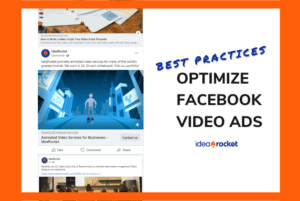When it comes to creating a quality video project, you can’t do it alone. You need a dedicated team of professionals to help achieve your goals — and the support of your organization to bring it all together.
However, getting executive or stakeholder buy-in can be a challenge. Upper management may not see the benefits of a quality animated or live action video as clearly as you do. At least, at the beginning.
Here are five tips to help create the case for video, and win over the C-suite:
1. Have a Plan
Before you even think about taking your video idea to the C-suite, you need to make sure you have a clear plan of action. You need to be able to answer every question that’s thrown at you, and you must able to backup your claims with clear examples, and data-driven goals. Sit down with your team and come up with an elevator pitch that satisfies every angle, and addresses any concerns that may arise. Some questions to consider:
- What problem are you trying to solve, and how can video help you achieve your goal?
- How will video be a more successful way to achieve your goal, compared to other techniques you’ve used in the past?
- What type of budget will you need to achieve your goals? Can you itemize the budget to clearly show how money will be allocated?
- What are the potential challenges, and how do you plan on approaching them?
- How will the use of video help impact the overall mission of the company, and impact the bottom line? (more on this later)
If you already have an idea for your video, or a specific series of videos, consider working this into your elevator pitch. Be sure to include:
- An overview of the narrative (what story are you trying to tell?)
- Potential production costs (this will differ, depending on whether it’s an animated video, or a live action video)
- How long it will take to complete your video project?
- How you plan to make the most of your video content (through advertising, repurposing content, on your website, social media, etc.)
2. Demonstrate Clear Use Cases
Let’s focus on that last point from above for a second. There is no shortage of data that indicates video is a growing trend. It’s a good idea to bring these numbers to your C-suite — but that’s not enough. In order to successfully persuade upper management to fully invest, you have to show why video is right for your company.
Look back at past projects: If your team has tried using video before, that’s a great place to start — especially if you have numbers that can show clear engagement or ROI. If not, you may want to try a pilot program to see if you can demonstrate success.
Check out your competitors: If you’ve never used video before, it may be worth checking out how your competitors are using it, so you can show clear examples from other leaders in your field.
Ask for feedback: Sometimes, client, customer, or employee feedback can show a need for video. For example, if you’re looking to create a HR or training video, you may want to ask employees how they feel about the current state of your training program, and how they would respond if video was introduced into the mix.
If you’re a SaaS company, it may benefit asking customers or clients if an explainer video would help them better understand your product. Or, you may want to ask your Sales team if they’d appreciate a video to play at trade shows or on demo calls.
3. Rally The Support of Your Team
This leads us to our next point — rallying support from your team. The more people you have on board with the project, the better. More people in your corner means more advocates. They may have their own use cases that could benefit them, and strengthen your case. For example, as a marketer you may be thinking of online uses, while a salesperson might see a video as a potential way of warming up a sales call, or including in an email to a prospect. When gathering support from your team, see if you can get written testimonials you can bring to the boardroom.
Rallying support from the rest of your team starts at the bottom. Start with your employees (the other team members who will be directly involved in the projects), their managers, the heads of departments — and work your way up to the CMO.
If you are the CMO, your biggest challenge is to get your CEO, or other members of the C-suite, on board. Your CEO, COO, or CIO can be your strongest ally when arguing the case for video to other internal or external stakeholders.
4. Set Benchmark Goals
While you may be able to sell the idea of video to your team, you need to back up your claims with hard, tangible numbers. If you don’t have a plan, your mission isn’t going to get off the ground. Make sure you set clear KPIs (key performance indicators) and have measurable benchmarks for your video project — and stick to them. You need transparency and accountability, so the C-suite can see you’re serious about your goals.
When setting your goals, you also need to account for the potential pitfalls or challenges that may come your way. While it’s great to be idealistic (after all, video’s the best, right?) you also need to be realistic. Sometimes, things don’t always go as planned, and success doesn’t happen overnight. Your stakeholders need to be aware of all facets of the project — the bad and the ugly, as well as the the good.
5. The Final Frontier: Demonstrating ROI
And by “the good” we mean the return on investment, or ROI. Because ultimately, that’s the end goal: How will your video project reap a larger ROI than other alternatives? When factoring ROI, consider all the ways video can make an impact, from generating brand awareness, to lead gen, or even the wealth of other content through repurposing.
A plan of action is backed by data-driven benchmarks, focused KPIs, and clear use cases. This will help you tell the story of how video will be successful for your organization in the long run.
As we said before, you can’t create a successful video campaign on your own. Learn how IdeaRocket can help you get started.




